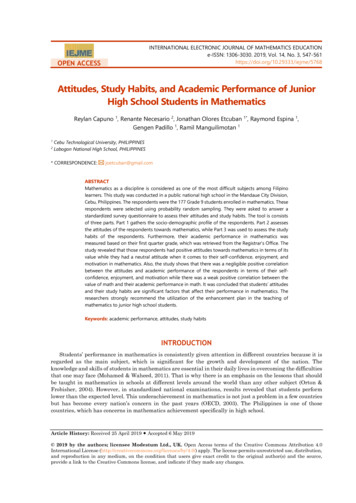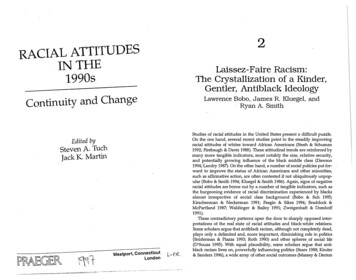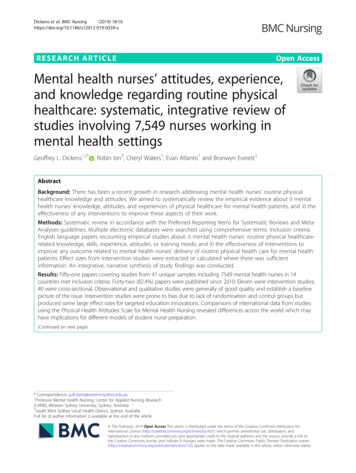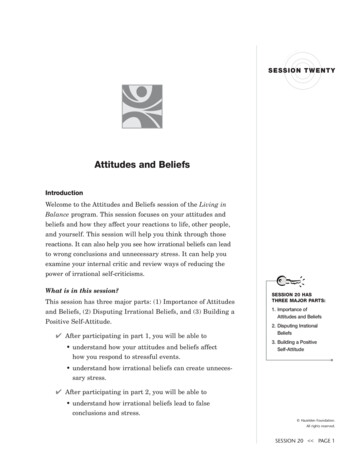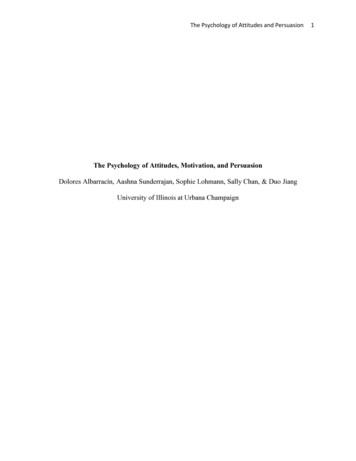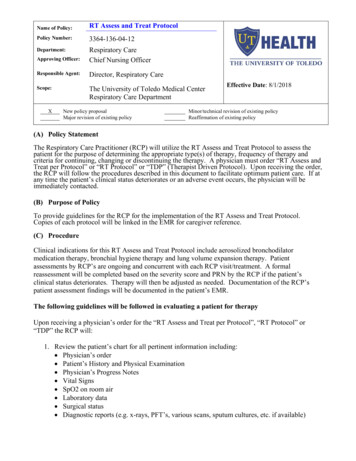
Transcription
Using Attitudes to Assess the Effectiveness of360-Degree Performance Appraisalin San Marcos, TexasJames BrooksAn Applied Research Project (Political Science 5397) Submitted ToThe Department of Political ScienceSouthwest Texas State UniversityIn Partial FulfillmentFor the Requirements for the Degree ofMasters of Public AdministrationFaculty Approval:
Author's NoteI wish to thank Carolyn Liner for her cooperation and valuable information that was neededfor this research project. I also wish to thank the following people for their cooperation andinformation as well: Larry Gilley, Laura Huffman, Bob Higgs, and Steve Griffith. Without thecooperation of these people, this project wouldn't have been completed. Hopefully this papermight lead to more public entities using 360-Degree Performance Appraisal for their ownproductivity and performance improvement.My deepest thanks,James Brooks
I wish to dedicate this research project to myparents Frank and Dee Brooks who havesupported me through the years and who encouraged my pursuit of higher education.
Table of ContentsChapter1MTRODUCTION.1Overview.1Research Purpose.2Chapter Summaries.32LITERATURE REVIEW.4Introduction to Performance Appraisal .4History of Perf. Appr.5What is Perf. Appr .5. .Revlewng an Employee. 6Elements of Performance Appraisal.8Purposes of Perf. Appr.8Validity of Perf. Appr .9Feedback.11360-Degree Performance Appraisal. 12360 Appr. as an Effective Tool.13Reasons to Use 360 Appr .14Process of 360 Appr. 15
Benefits of 360 Appr .17Managerial Performance.1 820Summary of Literature Review .Differences between Top-Down and 360 Appr .20The Future of 360-Degree Perf. Appr . 21Conceptual Framework.223RESEARCH SETTING. 25The City of San Marcos. 2525The Process.27Similarities and Differences.4METHODOLOGY.29Appropriateness of Method.29Strengths and Weaknesses of Focus Groups.30Implementation.305RESULTS.3333Hypothesis # I: Compensation Issues.Hypothesis #2: Empowerment.35Hypothesis #3: Supervisory/LeadershipSkills.36Hypothesis #4: Communication Between Coworkers.37Hypothesis #4a: Communication Between Employees/Supervisor.40Hypothesis #5: Increases Productivity and Performance.41
Summary of Findings.426CONCLUSION. .45Limitations of the Study. 48Appendix l-Transcript of Focus GroupAppendix 2-Survey Instrument Used by the City of San MarcosBibliography32Table 4.1: Summary Table 1.Table 5.1: Summary of Findings Table.43
Chapter 1Introduction
IntroductionOvet-viewIn any organization, h g h performance and productivity of all the employees and themanagement should be a focus if that organization is going to accomplish it mission. One wayto gauge how a person is performing is through the use of performance appraisals. Performanceappraisals let every employee, whether they be subordinates or management, know what isexpected of them in the particular job they are doing.Performance appraisal quantifies and develops performance and productivity inorganizations. "Performance appraisal is the systematic description of the job related strengthsand weaknesses of an individual or a group" (Cascio 1995,275). Performance appraisals comein many forms. Certain kinds of appraisals are better suited for certain organizations. One ofmanagement's tasks is to find the best type of appraisal that will fit their specific organizationbest. No matter the type of appraisal that is used though, all performance appraisals helpmanagement make decisions regarding personnel. "Performance appraisals include anypersonnel decisions that affect an employee's retention, termination, promotion, demotion,transfer, or change in salary" (Piatt 1998, 1).It may be hard for a manager or a management staff to decide on what kind of performanceappraisal to use on their organization. Most appraisals have the manager appraising hishersubordinate's performance and productivity about once a year. Sometimes though, the manageris not well equipped to do h s kind of assessment. "A typical manager has limited contact withhis or her employees; studies inhcate that managers spend only 5 to 10 percent of their
workweek with any one subordinate. Managers therefore have access only to a small sample oftheir subordinates work" (Cascio 1995,276). Managers, even if they don't admit it, sometimesneed help with the appraisal process. The 360-degree performance appraisal overcomes many ofthe aforementioned weaknesses of more traditional forms of employee performance appraisal.The 360-degree performance appraisal was developed not only to help managers with theappraisal process and the personnel decisions that go along with performance appraisal, but itwas also developed to increase the quality of the assessments as well. The 360-degreeperformance appraisal is more than the managers assessment of a specific employeesperformance and productivity. The 360-degree appraisal also takes into account the assessmentsof peers, coworkers, and subordinates.Supporters argue that management is more likely to get an accurate assessment of eachemployee. A big reason for this is the feedback from peers and coworkers. "Peers can providea perspective on performance that is different from that of immediate supervisors" (Cascio 1995,290). Peers and coworkers might have a better perspective of ways the employee can enhancetheir performance. Multiple raters bring increased objectivity to the appraisal as well. The 360appraisal may address the search by public administrators for "an evaluation instrument that atonce minimizes bias and subjectivity, promotes motivation and individual productivity andmaximizes the achievement of effectiveness and efficiency" (Pian 1998,3).Research PurposeThe purpose of this research is exploratory. Using the literature as a guide there is anexamination and assessment of a quasi-360-degree performance appraisal system used by TheCity of San Marcos. An assessment will be made as to the benefits and limitations of the SanMarcos system. Hopefully information obtained from the review of the literature and the
perception of employees can be used by mangers considering changinglimproving theiremployee appraisal process.Chapter SummariesChapW2, the Literature Review, provides historical information on performance appraisalsin general and 360-degree performance appraisals as well. Elements of performance appraisalsas well as purposes for conducting them will be discussed. Reasons to use 360-degreeperformance appraisal, the process of 360 appraisal and benefits of 360 appraisal will comprisemost of the section on 360-degree performance appraisal. The chapter also looks at the futureof 360-degree performance appraisal and concludes with the development of the conceptualframework and hypotheses. ! xQ&L& the Research Setting describes the organization withinwhich this research was conducted-The City of San Marcos. The chapter includes the actualprocess that The City of San Marcos went through in implementing a 360-degree performanceappraisal. The chapter also discusses similarities and differences between a normal 360-degreeappraisal and the system used by The City of San Marcos. ChaDter the Methodology chapter,focuses on the research technique used for this project-the focus group. The chapter discussesthe appropriateness of the method and strengths and weaknesses of focus groups will bediscussed as well. Qla&g & the Results, will break each hypothesis down and discuss themindividually. The results pertaining to each hypothesis are discussed. The hypotheses are eithersupported or supported. The chapter will end with a summary of the findings.Chader theConclusions, discuss the important findings made and implications for future research.Recommendations for future research of 360-deree performance appraisal in the field of publicadministration will also be addressed. The chapter will end with preliminary recommendationsto The City of San Marcos about limitations of their 360 appraisal system.
Chapter 2Literature Review
Literature ReviewIntroduction to Performance AppraisalPerformance appraisal is a tool that is used by both public and private organizations to trackthe productivity and performance of an individual in that organization. Performance appraisalhas been around for a long time and has gone through a variety changes. The purpose of thischapter is to examine the background of performance appraisals and 360-degree performanceappraisals and to see what role the appraisals play in personnel management. This chaptercontributes to the overall purpose of this research project by contrasting and comparing thetogdown performance appraisal with the 360-degree performance appraisal. In addition, usingthe literature discussed earlier, a conceptual framework (worlung hypothesis) which organizesfocus group discussion is presented.There are different versions of performance appraisals and ways in which to track anemployee's performance on the job. Traditional performance appraisal or ''top down appraisal"has been used by thousands of organizations.Dr. Deming, who developed the Total Quality Management movement after WWII, iscommonly know to have frowned upon the use of performance appraisals. The TQM movementfocuses on quality and deals with the processes and systems used to reach quality."Performance appraisals have become the preferred method for observing, evaluating, andmeasuring employee performance" (Cadwell 1995,24). Where did performance appraisalsoriginate? How did they become THE method of tracking employee performance at work? Thesection that follows discusses the history of performance appraisal as well as presents an4
in depth analysis the of performance appraisal. In addition, the process of employee review isdiscussed.LLLrto?yo f Perfor-raisalPerformance appraisal has been around for a long time. It was not originally developed forthe civilian workforce. It was developed in the Army. "One of the earliest recorded efforts atappraising job performance occurred an unlikely organization, the U.S. Army" (Cadwell 1995,23). Not long after that, some other branches of the government began implementing formalevaluations which are now known as performance appraisals.By the early 1900s, the private sector began tracking employee performance through anappraisal system. "The first formal evaluation process in private business is thought to havebeen initiated in 1913 by Lord & Taylor, a New York department store" (Cadwell, 24).The nature of employee appraisal has evolved and changed since the early days in the Army.Current appraisal systems can be very costly to implement and there is often a lack of employeesupport. "Performance appraisal has developed over the course of the century into a complexand costly management support tool" (Daley 1992,39).What exactly involved in the performance appraisal process? The next section examines theprocess of appraising employee productivity and performanceThe basic root function of performance appraisal is gauging where the employee is in hidherjob, how helshe is doing in that job, and what can be done to improve job performance, ifimprovements are necessary. "Performance appraisal is an exercise in observation andjudgement, it is a feedback process, and it is an intensely emotional process" (Cascio 1995,274).5
The emotional component of the performance appraisal process can be very distressing to theemployee as well as to the supervisor. Feelings can be hurt and walls can be put up between theemployee and the supervisor. How should a manager conduct the appraisal meeting?review in t&&lovee-The &ura;sa[ &&gGenerally, a performance appraisal occurs during a meeting between manager and employeewhere the employee job performance is discussed. The tone of the meeting usually depends onhow the manager conducts it. "The reviewee should have a fair, honest, and thorough hearing ashe presents his evaluations and plans for development and he should leave the review sessionfeeling that his superiors take his idea seriously and are vitally interested in his progress"(Rowland 1970,303).There are certain things to be done when an appraisal meeting takes place. "The boss shouldavoid any tinge of threatening attitude in his conduct of the appraisal interview. If he does notdo this, his appraisal group will become nervous as appraisal time approaches and the work willsuffer" (Rowland, 210). Nobody wants to be called into the managers ofice to be yelled at ortalked down to. This technique can be seen as a motivational tool but all it does is destroyproductivity because all the employee thinks about is the appraisal meeting and what will be saidduring it.Rowland maintains that while conducting the meeting, the manager should avoid telling theemployee that their performance needs improvement. "Specific cases should be called to theattention of the appraisee for they will help to make clear exactly what the appraisers meant bythe statement they made but should not take the form of a harsh reprimand (Rowland 1970,273).Some companies use the appraisal meeting as a chance to determine the appropriate payincreases for the employee. This practice is commonly know as pay-for-performance.6
According to Cadwell there are a few problems with the pay-for-performance technique. "First,there is the tendency of the employee to want to discuss examples of stellar performance and toexplain away anything that might negatively affect the increase" (Cadwell 1995,25) Theemployee can't be objective about the situation when compensation is involved. They don'twant to talk about anything that could be improved on because that could decrease the amount oftheir future pay. The meeting has the potential to become heated between the manager and theemployee. The discussion may become polarized.There is a second problem with pay for performance. "Another problem is company budgetsor personnel policies often dictate the amount of increase a manager can give an employee or agroup of employees" (Cadwell 1995,25). If an employee is counting on a certain amount ofraise and the manager can't give that amount then this can cause friction between the managerand the employee.If the employee doesn't take the appraisal process seriously there is a danger that the processwill become a formality. When an employee believes that he/she has been treated unfairly thenthe probability of the employee accepting the appraisal as valid is slim to none. "Rateeacceptance of a performance appraisal system is maximized when the performance measurementprocess is perceived to be accurate and the system is administered fairly" (Condrey 1994,48).The manager should do everything in their power to make sure that the appraisal systemaccurately depicts the performance of the employee.When managers try comparing employees they can create bad feelings and damage morale.Not only can the manager create friction among staff, but the manager can also become a targetfor hostility too. Now lets look at some of the elements of performance appraisal includingpurpose, validity, and feedback.
Elements of Performance AppraisalThere are aspects of the process that are necessary to performance appraisal. "Such elementsinclude rater training, setting of objectives, performance planning, employee participation,support from top-level management, establishment of formal written policies and documentationof appraisal" (Piatt 1998, 16). These elements, along with the components above, help to make aperformance appraisal system an accurate assessment of how an employee is performing on thejob.Employee evaluations are done for a number of reasons. "Appraisal serves a twofoldpurpose: I) to improve work performance by helping the employees realize and use their fullpotential in carrying out their firms missions and 2) to provide information to employees andmanagers for use in making work related decisions" (Cascio 1995,275). If a performanceappraisal helps an employee conduct company business with greater efficiency and productivitythen it has done the job it was created to do. The appraisal helps management make decisionsthat are pertinent to the organization and the employee. If an employee is not performing up tothe expectations set by the organization, it is up to the manager AND the employee to make thenecessary changes so that the employee will meet those expectations.In addition, performance appraisal bridges the gap between management and employees.Performance appraisal is used in judgmental decisions such as promotion, demotion, retention,transfer, and pay, and for employee development via feedback and training; it also serves theorganization as a means for validating selection and hiring procedures, promotingemployee-supervisor understanding, and supporting an organization's culture (Daley 1992,39).Documented performance is more important since society is so litigious. Appraisals can be adefense against lawsuits. Documentation of employee's performance is needed to protect8
an organization against an employee who has filed a wrongful termination suit. Thosecompanies who haven't carefully documented an employee's performance have come to regretit.Employee development is often overlooked in organizations. People have an intrinsic needto do good work and they want to be noticed for it. Those employees that do the best work havehigh morale and morale comes from the pressure to perform and produce."Morale and productivity are highest when there is pressure to perform. When people receiverewards without working for them, they are protected from failure and their self-esteem isdestroyed" (Eckes, 59). Just throwing money at an employee doesn't guarantee productivity.The employee needs to know that they have pressure to perform well. "People preferaccountability; they want their work to be judged and judged fairly" (Eckes 1994,59). If anemployee is put into an environment where there is no pressure to perform, then theemployees productivity will drop.In environments where employee development is stressed, the manager takes on the role of acoach rather than a boss. The manager points out places the employee need to improve andstrives to extract optimum productivity from hisiher subordinates.The employment of performance appraisal for developmental purposes helps strengthen theemployee-supervisor relationship where the supervisor is cast in the role of coach and adviserrather that of lord high executioner whch encourages teamwork and facilitates thedevelopment of good work behaviors (Daley 1992,48).yalidity of PerformanceMost employees are going to accept the results of an appraisal system if they consider itvalid. Validity refers to the notion that the appraisal is accurately tied to the performance of theindividual. "The validity of an appraisal system is a matter of its job relatedness, the question of9
whether the performance appraisal system accurately assesses and reflects a person's trueperformance" (Fleenor & Scontrino 1982,20). If the employees perceive that the system is notvalid then they will lose faith and not trust the manager or the appraisal. the loss of faith andtrust eventually leads to declines in productivity. "If the appraisal system is valid, the employeeswho receive high performance ratings are in fact the best performers and those employees whoreceive the lowest ratings are actually the poorest performers" (Fleenor & Scontrino 1982,70).According to Cascio (1995,277) the five components that must be present in anyperformance appraisal system are: 1) Relevance 2) Sensitivity 3) Reliability 4) Acceptabilityand 5) Practicality. Relevance refers to a correspondence between the elements identified ascritical to job performance and performance standards.refers to the extent to whichthe appraisal instrument can distinguish between good performance and poor performance.Reliable instruments result in similar scores under similar conditions.is the extentto which the process is accepted by supervisors and employees. Finally,means thatthe instrument can be used and understood by both management and employees. .The criteria used in the appraisal process is a big determinant of the validity of the appraisalprocess. If a manager is able to insert hidher bias into the appraisal then the validity decreases."The more subjective the rating criteria the easier it is for the raters' biases to enter into hisherevaluation" (Fleenor & Scontrino, 70). The appraisal system needs be as objective as possible toeliminate bias on the part of the supervisor.The courts have ruled on what exactly constitutes an objective performance appraisal. "Caselaw outlines six criteria for constructing objective performance appraisal systems: job analysis,work behaviors, communications, training, documentation, and monitoring combine to guide thedevelopment of systems capable of appraising performance" (Daley, 40). If an organizationconstructs an appraisal system that has at least these six objective criteria, the courts and the
majority, if not all, the employees should consider the system a valid appraisal of productivityand performance.Sometimes objective measures are not enough. Some managers are skeptical to the appraisalprocess. Managers that do not have a lot of self confidence just give all employees a satisfactorygrade. The managers fear of making enemies if they give a true rating that is belowsatisfactory. "Rather than confront their less effective subordinates with negative feedback inappraisal interviews and below-average salary increases, some supervisors take the easy way outand give average or above-average ratings to inferior supporters" (Cascio 1995,277).Whenmanagers fail to make tough decisions employees often loose confidence in the validity of theappraisal system. Further, if some employee know that helshe has been slacking off and doingmarginal work and yet receives an above average rating they will not improve and as aconsequence the organization, and the employee, will suffer for the lack of productivity.FeedbackFeedback plays a major role in performance appraisals. Employees need to know how theyare performing. Feedback, weather from coworkers or superiors, can help employees know whatthey need to improve on to increase their productivity.Feedback is the foundation upon which all uses of performance appraisals are constructed.Virtually every employee has a recurring question about his or her job. Performance appraisalshould answer that question clearly, specifically and regularly (Fleenor & Scontrino 1982,9).If an employee doesn't know what is wrong, how can they fix it? Feedback is not just tellingthe employee where they are falling behind in their work. The manager needs to interact withthe employee and work out a solution together with the employee so that both will havean understanding and know exactly what needs to be done." The recipient's supervisor andhuman resource professional have a responsibility to help the recipient sort out and make use of11
the feedback. The more negative and unsuspected the results, the more work is required"(Kaplan 1993,300).Feedback doesn't have to be positive all the time. In fact there is always something toimprove on. "Negative feedback seems more likely to trigger the search for more effectivebehaviors than positive feedback" (Atwater, Roush, & Fischthal 1995,40). When an employeethinks that they are a productive worker and they get negative feedback, then they will bemotivated to change their behavior. Those that receive positive feedback the majority of thetime will think that there is nothing that needs improvement. As a result, their productivity willlikely drop.Since performance appraisal is an ongoing process the employee has an idea of whether theyare measuring up to expectations. Those that don't know how their performance measures upmay become frustrated."To be most effective we should look at performance appraisals as an ongoing process. If youand your employees discuss performance only once a year, the time interval between meetingscan allow problems to develop that seriously affect performance" (Cadwell, 22).Formal performance appraisal is the end of a process that goes on all the time-a process thatis based on good communication between manager and employee. If the appraisal isongoing throughout the year then the appraisal process is easy and there are few surprises foreither the manager or the employee.360-Degree Performance AppraisalPerformance appraisals are a tool that most companies use in some form or another. Thetraditional top-down appraisals, were the subject in the first part of this paper. Now, attention isturned to a different form of performance appraisal, the 360-degree performance appraisal.The performance appraisal known as 360-degree appraisal is becoming more popular12
as time goes on. The 360-degree performance appraisal is an appraisal system that encompassesviews of employee's superior and coworkers/peers. Through 360-degree performance appraisalthe employee has the chance to review the supervisor-an element that isn't practiced withtop-down performance appraisals. "The use of 360-degree instruments has exploded during thepast ten to fifteen years. In fact, it is difficult to find a Fortune 1000 company in the UnitedStates that has not t i e d a 360-degree assessment somewhere in the organization at least once"(Dalton ,59)The 360-degree appraisal takes information from more than one source. This assessmentcollects information from peers, subordinates, and superiors so that the person can get a wellrounded, or 360-degree, view of their performance. "Here the traditional source for performanceappraisals-the individual's manager-is supplemented by other sources who have significantperspectives to provide which the manager may not have" (Tornow 1993,212). Ideally withmultiple assessment sources, the manager will have little doubt that every part of the employee'sperformance is checked and double checked. The more feedback the manager is given the betterthe appraisal process should go. And better yet, the employee will not think that they arecriticized solely by the manager. "A cardinal rule is that the more information one collects andthe greater depth of the information, the greater the commitment must be to the recipient on thepart of the organization and on the part of those who conduct such an exercise" (Kaplan 1993,299).,360-Degree A--ectiveToolEven though 360-degree appraisals are becoming a popular way to appraise manager andemployee performance and productivity, how effective are they? Is it a valid technique? Is itreliable9 "On the whole, both field and laboratory studies indicate that peer assessment is avalid and reliable evaluation procedure" (Saavedra & Kwun 1993,450).13
Some managers not only want to make sure that the employees are productive but they alsowant to coach them along through their development. Topdown appraisals could get in the wayof this. Through traditional topdown appraisal the manager is forced to give the employeefeedback that they may not want to hear. Then when the manager comes back to try to play the"coach" role after the appraisal, the employee may feel resentment or even distrust. "Manypsychologists have traditionally said "no" to the question of could a manager conduct ajudgmental interview with a subordinate on Monday and then hope to do an effective counselingjob on Tuesday. The counseling function becomes ineffective the moment judg
The 360-degree performance appraisal was developed not only to help managers with the appraisal process and the personnel decisions that go along with performance appraisal, but it was also developed to increase the quality of the assessments as well. The 360-degree performance appraisal is more than the managers assessment of a specific employees




